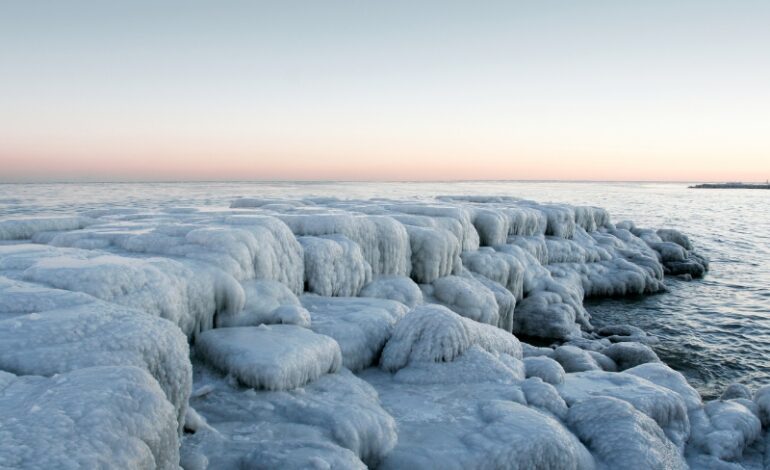Unveiling the Ice Age Mysteries

What is the Ice Age?

The Ice Age, a term synonymous with a frozen world of silent, snowy landscapes, refers to periods in Earth’s history when polar caps and glaciers expanded significantly. The most recent of these epochs, the Quaternary Ice Age, began around 2.6 million years ago and ushered in a series of glacial advances and retreats that sculpted our planet’s face.
This essay embarks on a journey through time, exploring the icy corridors of the past to uncover the secrets of the Ice Age. We’ll delve into the climatic intricacies, the life forms that braved the cold, and the indelible marks left upon the Earth’s geography, all while weaving a narrative that is as unique as it is informative.
The Sculpting of a World
Long before humans left their footprints in the snow, Earth witnessed the rise and fall of colossal ice sheets. These frozen behemoths crept across continents, carving valleys and shaping mountains. The Ice Age was not a static period but a dynamic cycle of freeze and thaw, with each glacial advance rewriting the Earth’s topography.
The Quaternary Ice Age, characterized by its rhythmic dance of glacials and interglacials, saw the rise of iconic landscapes. Fjords, moraines, and drumlins are but a few of the geological features born from the icy embrace of this epoch. These natural sculptures stand today as a testament to the power of ice over stone1.
The Celestial Choreography
What orchestrated these periods of intense cold? The answer lies in the delicate ballet of Earth’s celestial movements. Milankovitch cycles, named after the scientist who demystified them, describe the rhythmic changes in Earth’s orbit, tilt, and wobble. These variations alter the distribution of solar energy, setting the stage for the glacial symphony.
Volcanic eruptions and shifts in atmospheric greenhouse gases also contributed to the climatic fluctuations. Together, these factors initiated a cascade of environmental changes, plunging the Earth into periods of bitter cold that lasted for millennia.
Echoes of Life in the Ice

The Ice Age was a crucible for life, forging adaptations and resilience in the face of relentless cold. Flora and fauna either sought refuge in warmer climes or evolved strategies to cope with the chill. The megafauna—mammoths, mastodons, and their kin—became the emblematic figures of this era, their massive forms an adaptation to the frigid world.
Humans, too, were shaped by the Ice Age. Our ancestors donned the mantle of innovation, crafting tools and clothing to survive. The ice forged paths between continents, allowing early humans to wander and settle new lands. The challenges of the Ice Age were met with the ingenuity and spirit that define our species1.
Geographical Imprints of the Frozen Epoch

The Ice Age’s influence on Earth’s geography is undeniable. Glaciers, those slow-moving rivers of ice, etched their paths into the land, leaving behind a mosaic of geological features. The retreat of these glaciers marked the end of glacial periods, but their legacy remains etched in the Earth’s crust.
Sea levels ebbed and flowed with the growth and melting of ice sheets, reshaping coastlines and altering ecosystems. The Ice Age was a time of transformation, not just for the land, but for the life that depended on it. The world we know today is, in many ways, a product of these ancient climatic shifts1.
The Ice Age’s Enduring Influence
The Ice Age holds a mirror to our present, reflecting the potential for significant climatic shifts. It serves as a poignant reminder of Earth’s dynamic climate system and the adaptability of life. As we grapple with contemporary climate change, the Ice Age offers lessons in resilience and the importance of understanding our planet’s environmental rhythms.
The Ice Age’s narrative is far from over. Its whispers can still be heard in the rustling leaves of boreal forests and seen in the stark beauty of alpine landscapes. It continues to shape our environment, our science, and our imagination, challenging us to look beyond the present and into the vast, icy expanse of time.
Conclusion: A Legacy Carved in Ice

In closing, the Ice Age stands as a monumental chapter in Earth’s history, a period that witnessed dramatic transformations in climate, geography, and life. Its legacy is one of change and continuity, a reminder that our planet is a dynamic and ever-evolving home. The Ice Age’s story is one of endurance, a narrative that continues to unfold and inspire as we forge our path into the future.








![Top 5 Most Powerful Mysterious Creatures Of All Time[Updated 2024]](https://newsdailybeats.com/wp-content/uploads/2024/06/mystery-creatures-1.jpg)
